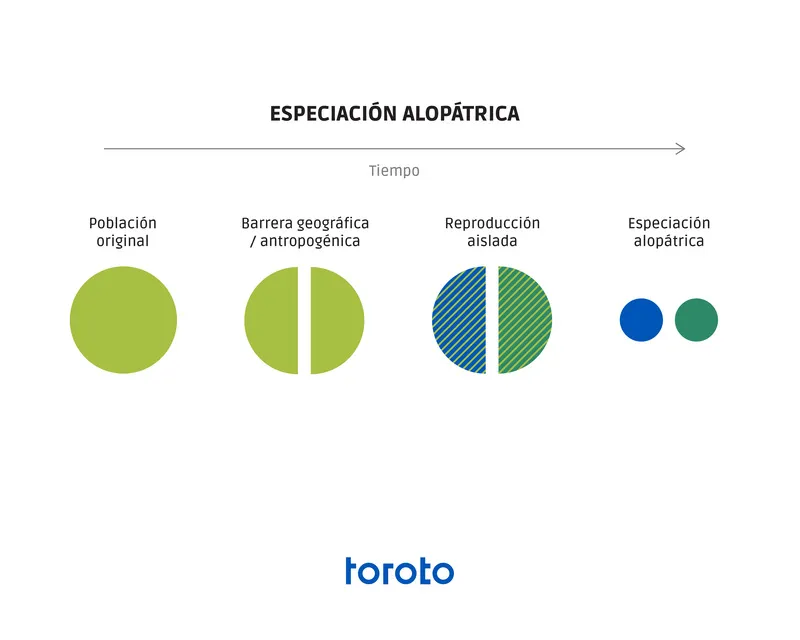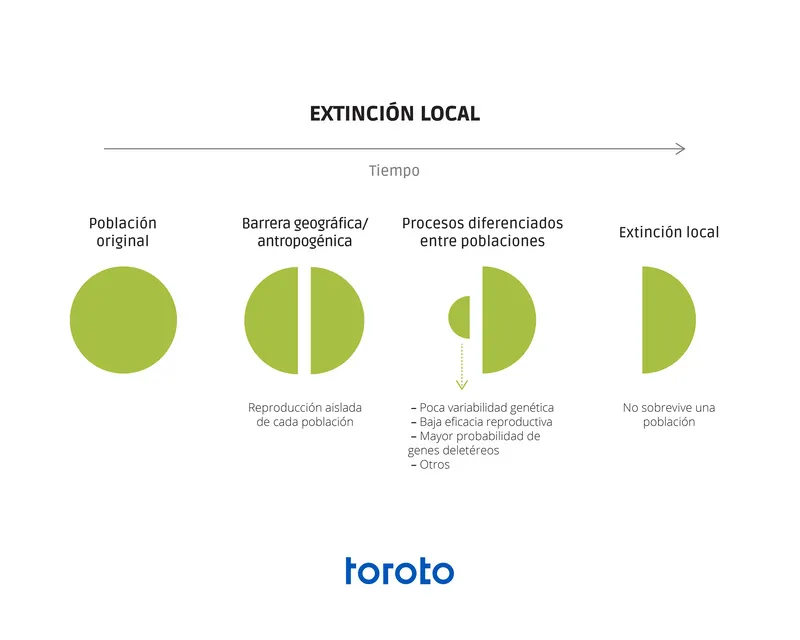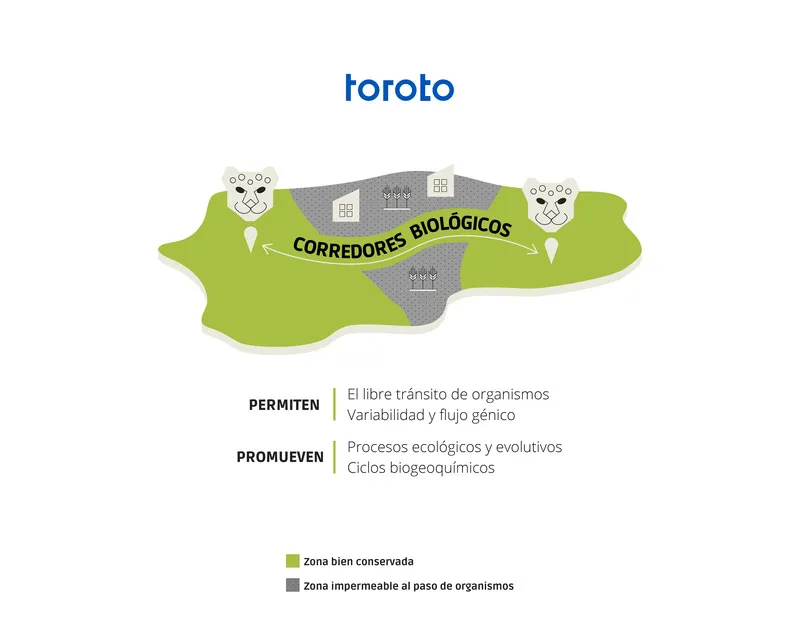Islands on Earth? From fragmentation to ecosystem connectivity



It's challenging to think about how the first islands on Earth were populated. Perhaps if we imagine organisms such as birds, this answer is simple, but how did the first rodents, the first beetles, snakes or snails arrive? Island biogeography is a branch of biology that seeks to explain the richness and abundance of species in remote and isolated regions of continental masses, so it emerges with it, the Island theory. However, soon after its creation, it was adapted to explain the same phenomenon in regions that were not necessarily surrounded by sea, but were surrounded by areas that were not friendly to the mobility of organisms in general. There are natural areas that restrict mobility, as in the case of geological formations such as mountain ranges or canyons, but today we will delve deeper into what happens under anthropogenic conditions. The fragmentation of ecosystems -when it is the result of human activities- such as those forests embedded in urban areas, or remnants of forests between intensively cultivated fields, are clear examples of islands on Earth.
Until that point in the story, we couldn't understand.
why we need connectivity to promote the natural course of life on the planet.
Island theory was proposed in 1967 by Robert MacArthur and Edward O. Wilson, and a few years later it became an important starting point for thinking about the conservation of terrestrial ecosystems. This bifurcated into two debates in themselves, on the one hand, the idea of whether national parks and other conservation strategies are really effective in not allowing the free mobility of organisms was rethought; and on the other hand, the size of the organisms that inhabit these restricted conservation areas was discussed, under a debate known as 'single large or several small', that is, one large organism or several small ones, since the necessary distribution area is not the same for an elephant as for a rodent, as is logical to think. In the same way, these debates - partly latent - gave rise to a last one: Should conservation be restricted in pristine areas, or mixed with human activities?
While the previous question marked lines of research within conservation in and of itself -and it is answered in another article- one of the most common questions, returning to the specific case of understanding conservation sites as islands on Earth, was: why should we worry about the area of an isolated nature reserve, or about the connectivity -or not- existing between this reserve and another one? When we have populations (a group of organisms of the same species) isolated over time and space, something curious begins to happen: gene flow decreases, that is, genetic and, therefore, phenotypic diversity within the same species begins to diminish because this hypothetical population has no one else to reproduce with except for its own group of organisms. This is serious. Although in some cases this situation leads to a process of speciation, that is, the creation of new species, it generally produces an imbalance in the reproductive capacity of the population, which directly impacts the predator-prey relationships in which these organisms are involved, and therefore, it usually leads to the fateful end of a local extinction. One of the most important needs for a functional ecosystem is that there be genetic and phenotypic variability between the biodiversity that inhabits it. Therefore, in answer to the question that many conservationists asked themselves at the time, and which today we reply at the beginning of this paragraph with just a little more clarity: the area of a reserve influences the number of organisms in a population that it can support; five jaguars on five thousand hectares are not the same as ten in the same area. The ecological relationships between jaguars and their prey change depending on the number of predators there are, but also on the amount of prey available. This is known as the carrying capacity of an ecosystem.
La correct territorial management to achieve a effective connectivity
between conservation areas It is one of the struggles most significant of our time.
On the other hand, the inference of the connectivity -or not- of one reserve with respect to another is essential to understand if the isolation of a population will lead us to a process of genetic stability, speciation -formation of new species- or local extinction -permanent disappearance of a species in the locality- since it is likely that if there is another preserved area nearby, this species in question can move and possibly find a reproductive partner that has not previously reproduced with someone from its original population. If the reserves are located at a significant distance from each other, and what connects them is a poorly permeable or inhospitable territory (the landscape is fragmented), as is the case in an extensive soybean field cultivated with the help of pesticides, the hypothetical species may not be able to reach the other reserve, and so it happens with its relatives, until at best, inbreeding and consanguinity make the isolated population reproductively incompatible with each other; and in the worst case, it leads them to local extinction.

Diagram 1. Allopatric speciation

Diagram 2. Local extinction
An endless number of positions emerged during the years following the publication of island theory and what it meant under the lens of evolutionary processes such as migration, speciation and extinction. However, one thing that became quite clear was that conservation should be understood from different scales, taking into account the landscape scale as a basis for allowing the ecological and evolutionary processes that take place within a community or a population of species to take place naturally. This, on the understanding that a nature reserve is not sufficient for such processes to take place. From these questions, an alternative emerges to the problem of what to do with these disjointed, fragmented and isolated conservation areas. That day they were born biological corridors, or rather, they always existed in nature, but until that point in history we could not understand why we need connectivity to promote the natural course of life on the planet.
Biological corridors are an effective strategy that responds to several limitations, such as those mentioned above, that conservationists did not know how to deal with. A biological corridor is, broadly speaking, an induced or natural space that allows connectivity between two conservation areas, thus avoiding total fragmentation of the ecosystem and the forced isolation of populations. These can range from large tracts of primary vegetation, to tunnels under roads and narrow strips of secondary vegetation. Obviously, some are more effective than others, and it is logical to think that those natural corridors, such as those large areas of primary vegetation, have a much more significant impact on natural cycles and on present biodiversity, than a tunnel under a road. Let's put it in other words: in the face of the environmental crisis we are experiencing, where biodiversity is in exponential decline, natural biological corridors -or those properly induced- are perhaps one of the most important alternatives to promote the evolutionary and ecosystem processes that give rise to and sustain life on the planet. Proper land management to achieve effective connectivity between conservation areas is one of the most significant struggles of our time. The following diagram helps us to understand from a landscape perspective what connectivity looks like when fragmentation is present.

Diagram 3. Landscape representation of the involvement of biological corridors
Now, something that we may not think about regularly, but on what we depend day in and day out, is that the establishment of biological corridors and the care of natural corridors has a direct impact on our relationship with nature and with the resources and services we perceive from it. Beyond allowing the free movement of organisms, biological corridors promote processes of pollination, water recharge, carbon sequestration, nutrient cycling, soil formation, climate regulation, and so on; this is why we must think of them as allies to unify and connect the life that still persists on our islands on Earth.
There are many ways to promote the establishment and care of biological corridors; at Toroto, we believe that ecological restoration hand in hand with nature-based solutions restores to ecosystems the functional capacities necessary to sustain and harbor life, provide ecosystem services, and also allow the passage of species. Although we may be thinking of biological corridors as areas perfectly delimited by a fence or mesh, we must understand that on a landscape scale, any territory permeable to as many organisms as possible can serve as a biological corridor. Could a reforestation between two conservation areas with native species be so? Although the scope and size are an important characteristic to take into account to make it as inclusive as possible for all organisms, as long as the area has territorial coherence and allows safe transit, it can act as a biological corridor; Here lies the importance of understanding nature conservation in an integral, and not atomized, way. Reforestation with native species is more than just reforestation; it promotes water recharge, soil formation, carbon sequestration, biodiversity and can also act as a connector between islands, thus addressing one of the most urgent situations of our time.
Life on Earth knows no limits, so restricting it to specific areas is an attack on its own nature. The debates that gave rise to all these concepts and theories are still in force, and of course, falsifiable as long as our knowledge to seek life continues to increase. The biodiversity crisis is one of the greatest challenges we have faced as humanity, not only because we cause it, but because reversing the damage implies a change in the collective mentality of our planet. While this change takes time, I am convinced that we are achieving it. The next time we look at a landscape from an airplane, a road, or somewhere very high, let's try to see it with a broader understanding. What is behind this landscape? How many organisms coexist in the same area? How are they different, how are they similar? Do they share needs? Is there connectivity, or is that landscape just another example of islands on Earth?
As painful as it is to say, often what we see is fragmentation between well-preserved areas. The simple fact of using a road speaks of a space that was split in two. Although we would enter into a speciesist and bioethical debate about whether the road does or the road does not, the really important thing to answer this specific debate is that understanding and awareness continue to grow; since we know what anthropogenic situations affect the landscape and the natural connectivity of ecosystems, let's do something to remedy it. Let's invest in ecological restoration projects, let's generate a more respectful relationship with nature, let's understand each other as part of the same Earth and not isolated entities. Let us know for sure that what affects the connectivity of the landscape also affects us.
About the author:
Sandra is Executive Editor in Toronto. He studied biology at the UNAM. He loves to read and be in nature.
Bibliography:
Explore reflections, research and field learning from our work in ecosystem restoration.